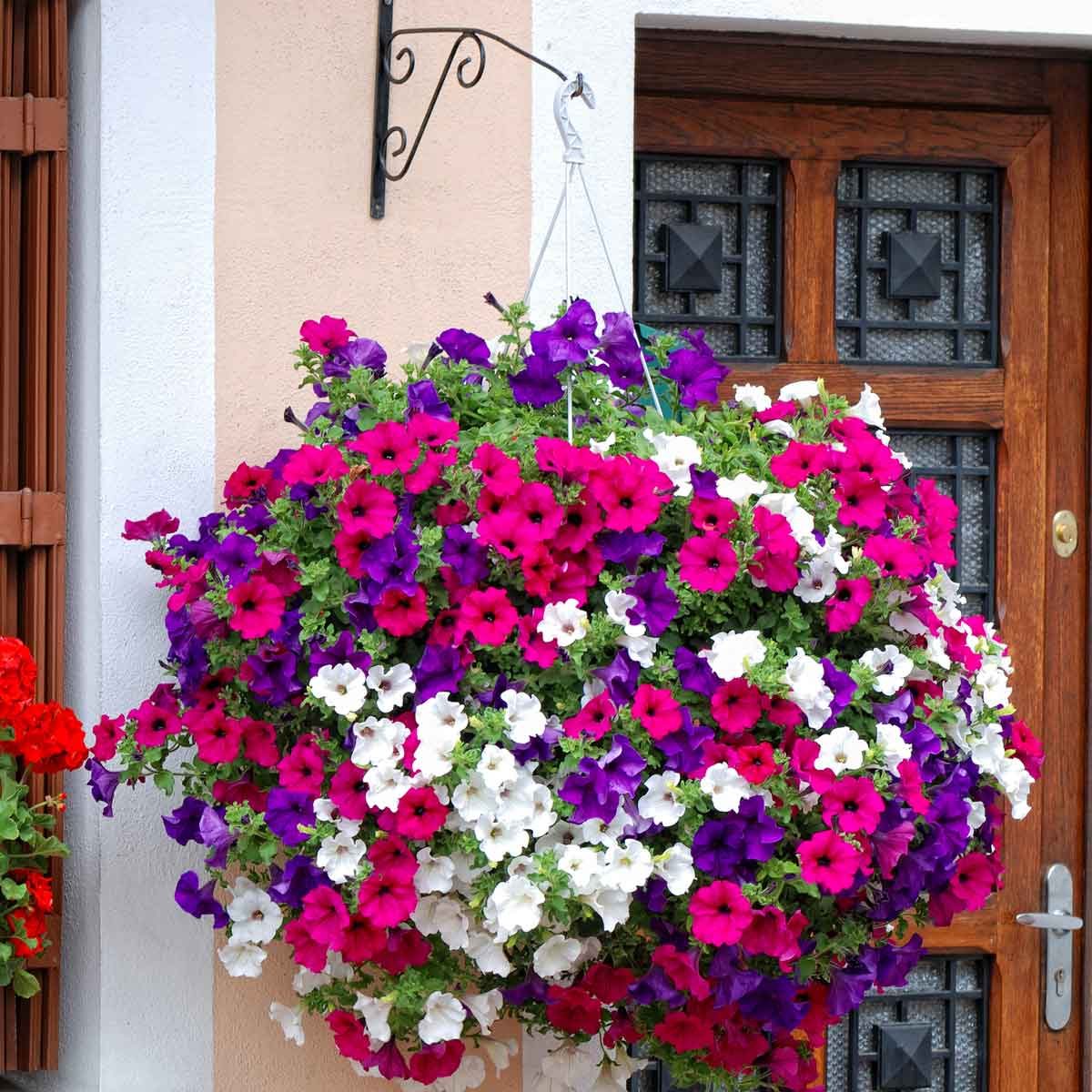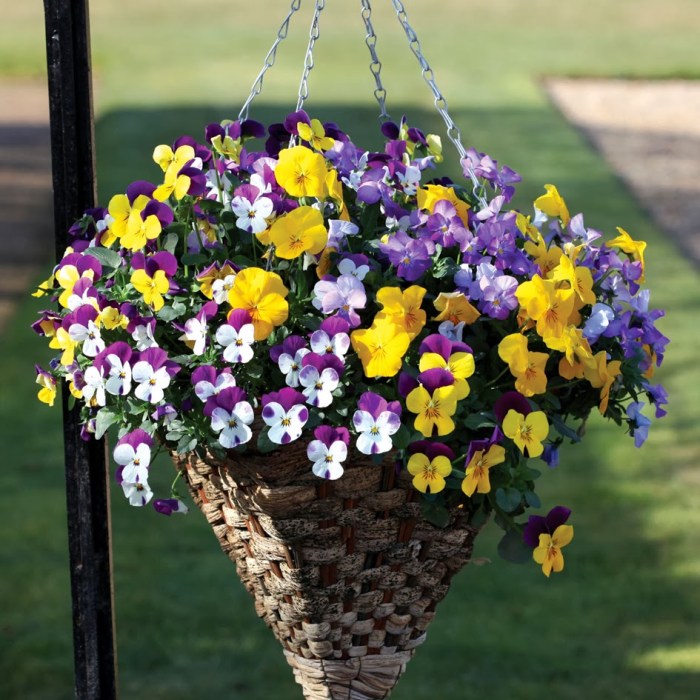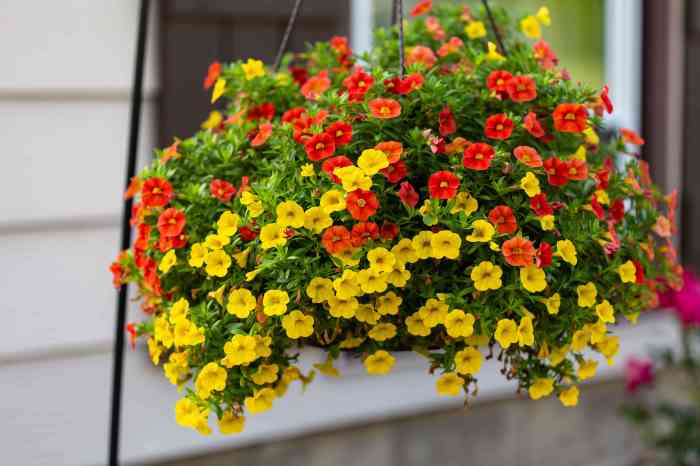Hanging plants and flowers bring a touch of nature indoors, adding vertical beauty and charm to any space. From lush greenery to vibrant blooms, these plants offer a versatile way to decorate your home while improving air quality and adding a touch of tranquility.
This comprehensive guide will explore the best hanging plants and flowers, provide tips for designing stunning arrangements, and discuss proper care and maintenance techniques. Whether you’re a seasoned gardener or just starting out, you’ll find everything you need to create a thriving indoor oasis with hanging plants and flowers.
Popular Hanging Plants
Hanging plants add a touch of greenery and elegance to any space. They are perfect for small apartments, balconies, or any room that needs a bit of life. Here are some of the most popular hanging plants and their specific characteristics:
Spider Plant
- Long, slender leaves with variegated patterns
- Produces plantlets or “spiderettes” that can be propagated
- Prefers bright indirect light, but can tolerate low light
- Water when the soil feels dry to the touch
- Prefers temperatures between 60-80°F (16-27°C)
Pothos
- Trailing vines with heart-shaped leaves
- Available in a variety of colors, including green, yellow, and white
- Prefers bright indirect light, but can tolerate low light
- Water when the soil feels dry to the touch
- Prefers temperatures between 60-80°F (16-27°C)
String of Pearls
- Delicate vines with small, bead-like leaves
- Prefers bright indirect light
- Water sparingly, allowing the soil to dry out completely between waterings
- Prefers temperatures between 60-75°F (16-24°C)
Burro’s Tail
- Trailing vines with fleshy, cylindrical leaves
- Prefers bright indirect light, but can tolerate full sun
- Water sparingly, allowing the soil to dry out completely between waterings
- Prefers temperatures between 60-75°F (16-24°C)
Wax Plant
- Upright stems with thick, waxy leaves
- Available in a variety of colors, including green, red, and yellow
- Prefers bright indirect light
- Water when the soil feels dry to the touch
- Prefers temperatures between 60-80°F (16-27°C)
Best Flowers for Hanging Baskets

Hanging baskets are a beautiful and versatile way to add color and life to your home or garden. They can be used to create a variety of looks, from cascading waterfalls of blooms to lush, leafy displays. When choosing flowers for hanging baskets, there are a few things to keep in mind, including blooming time, color, and growth habit.
Annuals are a great choice for hanging baskets because they bloom profusely and continuously throughout the summer. Some popular annuals for hanging baskets include petunias, impatiens, begonias, and marigolds. Perennials are a good choice for hanging baskets if you want flowers that will come back year after year.
Some popular perennials for hanging baskets include geraniums, fuchsias, and lobelia.
Choosing Flowers Based on Blooming Time
When choosing flowers for hanging baskets, it is important to consider the blooming time of each plant. You want to choose a variety of plants that will bloom at different times throughout the summer so that you have a continuous display of color.
Hanging plants and flowers add a touch of nature and beauty to any space. For those looking for a more delicate touch, hanging plants with small leaves offer a variety of options. From the delicate tendrils of hanging plants with small leaves to the lush foliage of ferns, these plants bring a sense of tranquility and elegance to any room.
Whether you’re looking to add a pop of color or simply create a more inviting atmosphere, hanging plants and flowers are a versatile and charming addition to any home.
For example, you could choose early-blooming plants like pansies and violas, mid-season bloomers like petunias and impatiens, and late-blooming plants like chrysanthemums and asters.
Choosing Flowers Based on Color
The color of the flowers you choose for your hanging baskets is a matter of personal preference. However, there are a few things to keep in mind when choosing colors. First, consider the overall color scheme of your home or garden.
You want to choose colors that will complement your existing décor. Second, consider the size of your hanging baskets. Darker colors will make your baskets look smaller, while lighter colors will make them look larger. Finally, consider the amount of sunlight your hanging baskets will receive.
Some flowers, like petunias and impatiens, can tolerate full sun, while others, like begonias and fuchsias, prefer partial shade.
Choosing Flowers Based on Growth Habit
The growth habit of the flowers you choose for your hanging baskets will determine how they look and how much maintenance they require. Trailing plants, like petunias and impatiens, will cascade over the sides of your baskets, creating a beautiful waterfall effect.
Hanging plants and flowers are a beautiful way to add life to any home. For those looking for a more unique way to display their greenery, half hanging baskets are a great option. Bunnings offers a wide variety of half hanging baskets half hanging baskets bunnings , so you’re sure to find the perfect one for your needs.
Whether you’re looking for a traditional basket or something more modern, Bunnings has something for everyone. With a half hanging basket, you can create a beautiful display of your favorite plants and flowers that will add a touch of elegance to any room.
Upright plants, like geraniums and fuchsias, will grow more vertically, creating a more formal look. Mounding plants, like begonias and lobelia, will form a dense, rounded shape.
Designing Stunning Hanging Arrangements: Hanging Plants And Flowers
Creating visually appealing hanging arrangements is an art form that can transform any space into a lush, vibrant oasis. By combining different plants and flowers with varying colors, textures, and heights, you can create arrangements that are both eye-catching and harmonious.
Incorporating Decorative Elements
In addition to plants and flowers, you can also incorporate decorative elements to add a touch of whimsy and elegance to your hanging arrangements. Ribbons, bows, and beads can be used to create a cohesive look, while wind chimes and other trinkets can add a touch of personality.
When designing a hanging arrangement, it’s important to consider the following factors:
- Color:Choose plants and flowers with complementary colors to create a visually pleasing arrangement. You can also use contrasting colors to create a more dramatic effect.
- Texture:Combine plants with different textures to add interest and depth to your arrangement. For example, you could pair smooth-leaved plants with textured foliage or add a touch of sparkle with variegated leaves.
- Height:Vary the heights of your plants and flowers to create a more dynamic arrangement. Taller plants can be placed in the center, while shorter plants can be placed around the edges.
Care and Maintenance of Hanging Plants

Maintaining the health and beauty of hanging plants requires proper care and attention. Regular watering, fertilization, and pruning are essential for optimal growth and appearance.
Watering
- Hanging plants require consistent moisture, but overwatering should be avoided.
- Allow the soil to dry out slightly between waterings, and water thoroughly until water drains from the drainage holes.
- Use room-temperature water and avoid using hard water, as it can accumulate minerals in the soil.
Fertilizing
- Fertilize hanging plants regularly during the growing season with a balanced liquid fertilizer.
- Follow the instructions on the fertilizer label for dosage and frequency.
- Avoid over-fertilizing, as it can burn the plant’s roots.
Pruning
- Regular pruning helps control growth, remove dead or damaged foliage, and encourage bushier growth.
- Use sharp, clean shears to trim back overgrown stems and remove any yellowed or wilted leaves.
- Prune lightly throughout the growing season to maintain the desired shape and size.
Common Pests and Diseases, Hanging plants and flowers
Hanging plants are susceptible to common pests and diseases, including aphids, mealybugs, and root rot.
To prevent pests, regularly inspect plants for signs of infestation and treat promptly with appropriate insecticides or neem oil.
Hanging plants and flowers can add a touch of nature and beauty to any indoor or outdoor space. If you’re looking for a stylish and functional way to display your greenery, consider investing in a Bunnings pot hanger . These durable and affordable hangers come in a variety of styles and sizes, making them perfect for any home or garden.
With a Bunnings pot hanger, you can easily create a lush and inviting atmosphere with your favorite plants and flowers.
Root rot is a fungal disease that can be prevented by avoiding overwatering and ensuring proper drainage.
Innovative Uses for Hanging Plants

Hanging plants have evolved beyond their traditional role as decorative accents. Today, they are being creatively employed to transform living spaces and enhance well-being.
One innovative use of hanging plants is as room dividers. Suspending them from the ceiling or mounting them on walls can create distinct zones within a room, separating areas for different activities or creating privacy.
Privacy Screens
Hanging plants can also serve as effective privacy screens. Placing them strategically along windows or doorways can obscure views from outside while still allowing natural light to filter through. This technique is particularly beneficial in urban environments or homes facing busy streets.
Living Art Installations
Hanging plants can be transformed into living art installations by arranging them in unique and eye-catching ways. Grouping plants with contrasting colors, textures, and shapes can create a vibrant and dynamic display. Suspending them at different heights and angles adds depth and visual interest.
Improved Air Quality
In addition to their aesthetic appeal, hanging plants offer practical benefits. They can help improve indoor air quality by absorbing pollutants and releasing oxygen. Studies have shown that certain plants, such as spider plants and peace lilies, are particularly effective in removing harmful toxins from the air.
Touch of Nature Indoors
Hanging plants bring a touch of nature indoors, creating a calming and inviting atmosphere. Their lush foliage and vibrant colors can reduce stress, boost mood, and enhance overall well-being. They can also help to connect people with nature, even in urban environments where access to green spaces is limited.
Last Point

Hanging plants and flowers are a beautiful and versatile addition to any home. With proper care and maintenance, they can thrive for years, bringing joy and beauty to your living space. Embrace the vertical dimension and add a touch of nature to your home with these stunning plants and flowers.
Query Resolution
What are the most popular hanging plants?
Some of the most popular hanging plants include spider plants, pothos, philodendrons, and ferns.
What are the best flowers to grow in hanging baskets?
Good choices for hanging baskets include petunias, impatiens, begonias, and geraniums.
How do I design a stunning hanging arrangement?
Consider combining plants with different textures, colors, and growth habits. Use decorative elements like ribbons or beads to add a touch of whimsy.
How often should I water my hanging plants?
Water hanging plants when the soil feels dry to the touch. Avoid overwatering, as this can lead to root rot.